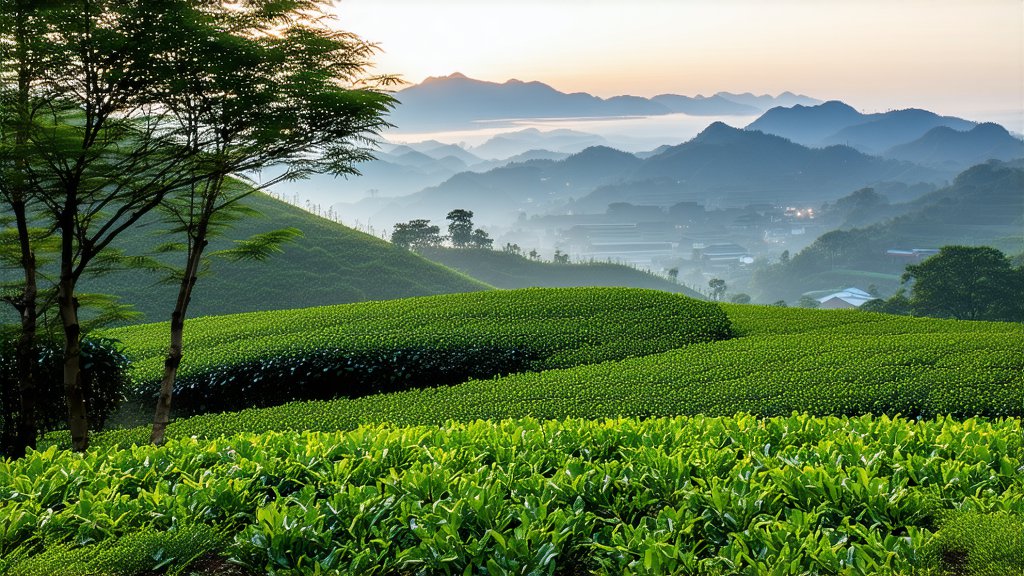
In the vast and diverse landscape of Chinese tea culture, few varieties have garnered as much admiration and intrigue as Tieguanyin, a distinguished member of the Oolong tea family. This exquisite tea, originating from the mountainous region of Anxi County in Fujian Province, China, is not merely a beverage but an experience that bridges history, tradition, and art. As we embark on this journey through the world of Tieguanyin, we will explore its historical roots, delve into its unique varieties, unravel the intricate process of its creation, and guide you through the nuanced art of tasting this remarkable tea.
Historical Tapestry: The Birth of Tieguanyin
The tale of Tieguanyin begins in the early 18th century during the Qing Dynasty, making it a relatively young addition to the long lineage of Chinese teas. Its name, translating to "Iron Buddha," pays homage to the Guanyin菩萨 (Goddess of Mercy), symbolizing purity and compassion. Legend has it that the tea was discovered by a poor scholar named Wei Yin, who found a wild tea plant growing near a temple dedicated to Guanyin. Impressed by its quality, he propagated the plant, which eventually bore his name—Tie Guan Yin. Over centuries, this tea evolved, becoming synonymous with high-quality Oolong tea production.
A Symphony of Varieties
Tieguanyin is not monolithic; rather, it encompasses a range of cultivars, each with distinct characteristics. The most renowned among them include:
- Xiang Xing: Known for its floral aroma and light taste, often reminiscent of orchids or magnolias.
- Ben Shan: Translated as "original mountain," these teas come from the earliest known plantings and are prized for their complexity and depth.
- Mao Xie: Meaning "feather picking," this refers to the meticulous hand-picking process that ensures only the finest leaves are selected.
- Dong Ding: Named after Dong Ding Mountain, this variety boasts a richer flavor profile and is often used as a benchmark for quality comparison.
Each variety offers a unique window into the terroir of Anxi County, reflecting the microclimates and soil conditions that shape their flavors.
Crafting Perfection: The Making of Tieguanyin
The artistry behind Tieguanyin lies in its meticulous production process, which combines traditional techniques with an acute understanding of nature's rhythms. Here's a glimpse into this intricate dance:
- Plucking: Only the tenderest leaves and buds are handpicked, typically during the spring harvest when they contain optimal nutrients and flavors.
- Withering: Freshly picked leaves are spread out under the sun or indoors to reduce moisture content, softening the leaves for rolling.
- Rolling & Oxidation: Leaves undergo a series of rolling and partial oxidation steps, where enzyme activity transforms the leaf's chemical composition, creating unique flavors and aromas. This stage is crucial in defining the tea's character.
- Fixation: To halt oxidation, leaves are quickly heated in a wok or over hot air, preserving their vibrant green color and locking in flavors.
- Shaping & Drying: The fixed leaves are further shaped and dried to achieve the desired moisture level, ensuring longevity without refrigeration.
- Sorting & Grading: Finally, the tea is sorted based on size, shape, and quality before packaging.
This careful balance between man and nature results in a tea that embodies harmony and precision.
The Dance of Flavors: Tasting Tieguanyin
To truly appreciate Tieguanyin, one must engage in the ritual of tasting. Here’s how to embark on this sensory adventure:
- Preparation: Use a Yixing clay teapot or a Gaiwan for brewing, as they enhance the tea's flavors and maintain temperature consistency. Warm the vessel with hot water before adding the tea leaves.
- Measurement: For every 100ml of water, use approximately 5 grams of loose leaves or two teaspoons if using pre-packaged leaves.
- Water Quality: Use fresh, soft water heated to around 90°C (194°F). Hard water can overpower the delicate flavors of Tieguanyin.
- First Infusion: Steep for about 30 seconds to rinse the leaves and awaken their aroma. Discard this infusion.
- Subsequent Infusions: Submerge the leaves for 1-2 minutes per steep, gradually increasing the time for later infusions to extract different flavor notes.
- Observation: Note the tea's color, clarity, and viscosity. Tieguanyin typically yields a golden-amber hue.
- Smelling: Appreciate the evolving aromas released from each steep—floral, fruity, roasted, or creamy notes may prevail.
- Tasting: Take small sips, allowing the tea to coat your palate fully. Pay attention to its sweetness, bitterness, umami, and aftertaste. High-quality Tieguanyin should offer a smooth, lingering finish with minimal astringency.
Remember, tea appreciation is subjective; personal preferences play a significant role in savoring Tieguanyin's multifaceted charm.
Conclusion: A Timeless Elixir
Tieguanyin stands as a testament to China's profound relationship with tea, embodying centuries of wisdom, innovation, and cultural heritage. Its journey from wild shrub to global icon reflects humanity's quest for perfection in simplicity. Whether you're a seasoned connoisseur or a curious novice, exploring Tieguanyin invites you to partake in a tradition that transcends borders and time, offering a moment of tranquility amidst life's chaos. So, brew yourself a pot, immerse yourself in the symphony of flavors that is Tieguanyin, and let your senses be transported to the misty mountains of Anxi County.